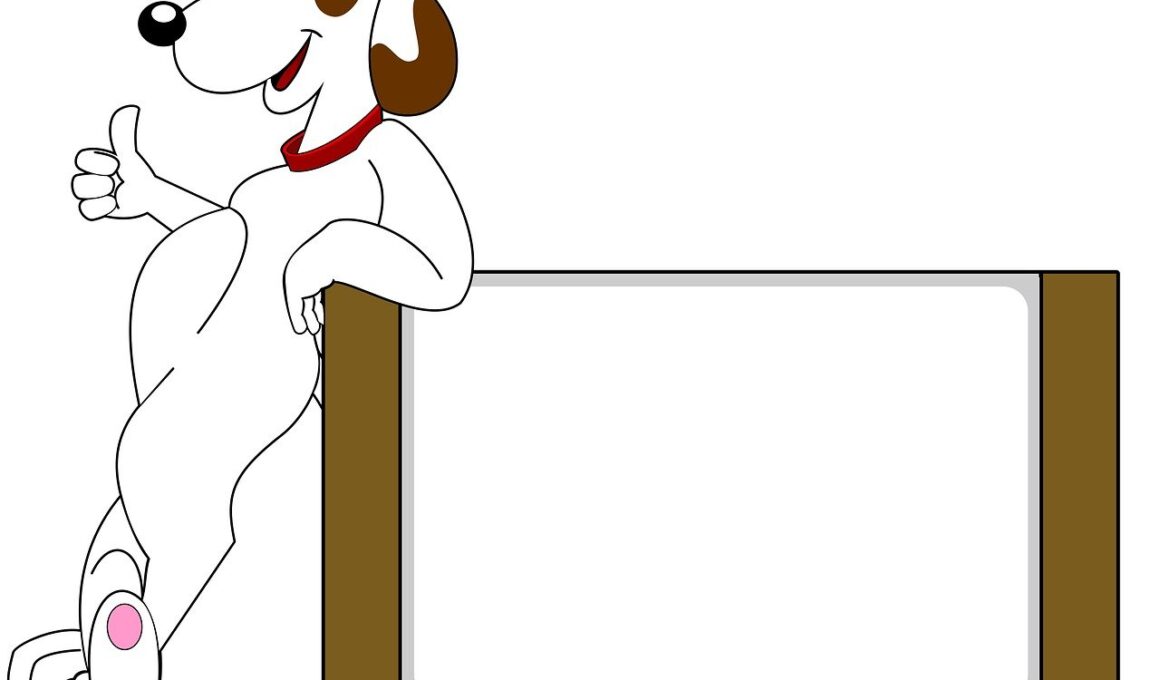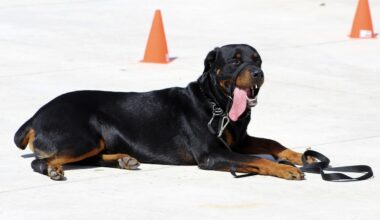Incorporating Family in Positive Dog Training Practices
Positive dog training focuses on reinforcing desired behaviors through rewards rather than punishment. Involving family members in this approach can enhance training effectiveness. Firstly, clearly define everyone’s role in training sessions. It can be beneficial to consist of all family members to ensure consistency in commands and rewards given to the dog. Secondly, utilize a unified cue system, which means everyone should use the same verbal and non-verbal signals while training. For example, if one person uses ‘sit’ and another uses ‘down,’ confusion occurs. Consistent cues help your dog understand expectations, improving communication. Additionally, schedule regular training sessions that fit all participants’ timings, which keeps family engagement high. This consistency of effort solidifies training in a dog’s mind. Moreover, involving children in training promotes understanding and responsibility towards the dog. Lastly, celebrate training milestones as a family. Acknowledging accomplishments, whether small or large, reinforces positive interactions and encourages everyone. Collaborative efforts create a bonding experience that enriches the relationship between the dog and family, ensuring your furry companion thrives in a nurturing environment.
Incorporating family members in dog training also means sharing responsibilities effectively. Begin by assigning specific tasks based on family members’ ages and abilities. Children can be involved in basic commands, like sitting or staying, while adults can manage more complex behaviors like leash walking. This breakdown of tasks not only promotes teamwork but also utilizes the strengths of each family member, maximizing training sessions. Moreover, remember that positive reinforcement works best universally. While children can use treats, adults may employ praise or toys. It’s essential to be clear about rewards, as they motivate dogs to learn. Create a chart accessible to everyone to track each family member’s contributions. This encourages accountability and celebrates everyone’s role in training the dog. Family group meetings can be held to discuss progress, challenges, and any needed adjustments to training strategies. Recognizing these aspects ensures each person’s input is valued, fostering a collaborative training environment. Additionally, including everyone keeps training sessions light and fun, preventing monotony. When the entire family participates and communicates smoothly, dogs are more likely to respond positively, resulting in enhanced learning and behavioral improvement.
Enhancing Bonding Through Group Activities
Utilizing group activities aids in solidifying the bond between family members and the dog through shared experiences. Activities like group walks, play sessions, and even dog-friendly family outings create memorable moments while reinforcing training principles. Sharing responsibilities during these activities allows everyone to contribute uniquely, enhancing the dog’s learning experiences in natural environments. For example, one person can be responsible for holding the leash, another can reward the dog, and another can focus on commands. These collaborative tasks help dogs associate training with positive experiences, as they learn in interactive settings. Daily routine activities can also become training opportunities; taking turns feeding or grooming the dog integrates training into everyday life. When each family member enjoys these moments, the dog feels the love and positivity radiating from them, strengthening the bond. Consider enrolling in family-oriented dog training classes or workshops, which can synchronize learning styles among family members. Most importantly, always celebrate achievements, no matter how small. These jubilations help foster a unified environment of encouragement and support, emphasizing that positive training techniques are achievable and rewarding when approached collaboratively.
Creating a structured training schedule helps the entire family stay involved consistently. To ensure effective training, establish a daily or weekly agenda that includes specific training activities. Schedule short, engaging sessions that can fit into everyone’s timeline, ideally around ten to fifteen minutes each. This lessens pressure on the dog and maintains engagement from family members throughout the training process. For instance, designate specific days for teaching new commands, practicing existing ones, and engaging in fun dog games that reinforce training principles. Use a shared calendar or group messaging system to keep track of sessions, allowing family members to comment on progress. Emphasizing the significance of regular practice is essential; sporadic training can confuse the dog and hinder progress. Incorporate family discussions about what works best and adapt techniques based on experiences. For practices that become more routine, introduce a rotating responsibility system among family members. Everyone’s participation fosters shared enthusiasm towards the training objectives, enhancing overall teamwork. Each family member’s unique insights can lead to discovering new training approaches, making the process more enriching for the dog and the family alike.
Emphasizing Consistency and Communication
Consistency is crucial in positive dog training, especially when the entire family is involved. Establish clear communication norms to eliminate confusion for both the dog and family members. Consider having family meetings regularly where success stories, challenges, and insights can be shared openly. This encourages dialogue and fosters an environment of shared responsibility and learning. During these discussions, outline each family member’s preferred training methods and align them to reflect collective agreements. This consistency ensures your dog is less likely to be confused by mixed signals. As part of this commitment, periodically evaluate training techniques, adjusting as necessary to improve effectiveness. Keeping communication lines open supports a united front in dog training, ultimately leading to more positive behaviors over time. Challenges are natural; however, collaborative problem-solving becomes a strong tool in addressing any setbacks encountered. Avoid casting blame if expectations aren’t met; instead, encourage team discussions to revisit strategies. Recognizing that training takes time reduces stress, allowing for open-mindedness towards gradual improvement. When the whole family stays engaged and communicates collectivel, it increases the likelihood of successful outcomes in positive dog training practices.
Positive reinforcement isn’t only beneficial for the dog; it serves as a rewarding experience for the entire family as well. Share in the excitement of your dog’s progress. Celebrate milestones, big or small, showcasing affection and encouragement. Making a family tradition of recognizing achievements reinforces connections among members while magnifying motivation for the dog. Whether it’s a treat ceremony, a special outing, or simply sharing fun anecdotes of the dog’s training escapades during family meals, these activities solidify the collective energy around training. Blind spots or difficulties in training can often arise when the family isn’t synergized. Therefore, remain attentive to one another’s feedback and acknowledge contributions. If a family member provides suggestions that can enhance the training experience, be receptive and willing to incorporate fresh ideas. Participation from everyone fosters a positive training environment. Additionally, consider documenting the dog’s journey through updates, videos, or photos shared among family members. This practice will encourage each member to be involved consistently while instilling a sense of unity in helping the dog become the best version of itself. The memories created through this bond last a lifetime.
Encouraging a Lasting Family Commitment
Committing to a positive training philosophy as a family will benefit everyone in the long run. Owning a dog is a long-term responsibility, and cultivating a training mindset can significantly enhance the experience. Aside from focusing on skills and behaviors, build a supportive environment that emphasizes each member’s role. Create an atmosphere where questions can be raised openly without judgement, promoting a sense of teamwork. Adjust the training practice as necessary based on ongoing discussions; improvements can be continually made when everyone contributes ideas. Moreover, experiencing ups and downs together reinforces resilience, teaching valuable lessons for both human and canine family members alike. Include educational resources for the family to grow together, whether through recommended books, videos, or attending workshops collectively. Encouragement and excitement will help transform the dog training experience into a rewarding journey for the entire family. All families can successfully navigate the growth and challenges that arise by remaining committed to learning through positive approaches. Building a strong foundation of training principles creates harmony within the household and nurtures a well-adjusted, happy dog.
In conclusion, the journey of positive dog training is a fulfilling experience that unites families while enriching their relationship. Involving everyone enhances the effectiveness of training, as mutual support and shared experiences help maintain enthusiasm and consistency. With structured roles and responsibilities in place, each member’s contribution blends seamlessly into a unified training effort. Positive reinforcement not only transforms the dog’s behavior but also strengthens family bonds through joyful interactions and shared successes. When challenges arise, collaborative problem-solving promotes resilience and encourages continued engagement in the process. This atmosphere fosters open communication about training practices, ensuring that everyone is on the same page. It’s vital to appreciate and celebrate achievements together, reinforcing the idea of teamwork and shared responsibility. Remember, training a dog is a lifelong endeavor that evolves with time. A strong commitment from all family members ultimately leads to a well-behaved and happy dog, enriching the home life for everyone involved. Embrace the joy of positive dog training with your family, as each success lays the groundwork for a loving, harmonious existence shared with your furry companion.


